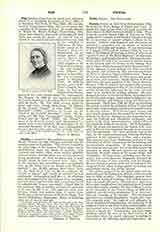

Pistoia, SYNOD OF, held 18 to September 28, 1786, by Scipio de’ Ricci, Bishop of Pistoia and Prato. It marks the most daring effort ever made to secure for Jansenism and allied errors a foothold in Italy. Peter Leopold, created Grand Duke of Tuscany in 1763, emulated the example of his brother, Emperor Joseph II, in assuming to control religious affairs in his domain. Imbued with Regalism and Jansenism he extended a misguided zeal for reform to minutest details of discipline and worship. In two instructions of August 2, 1785, and January 26, 1786, he sent to each of the bishops of Tuscany a series of fifty-seven “points of view of His Royal Highness” on doctrinal, disciplinary, and liturgical matters, directing that diocesan synods be held every two years to enforce reform in the Church and “to restore to the bishops their native rights abusively usurped by the Roman Court”. Of the eighteen Tuscan bishops but three convoked the synod; and of these his only partisan was Scipio de’ Ricci in whom he found a kindred spirit. Born in 1714 of an eminent family, de’ Ricci gave early promise of worth and eminence. Made Bishop of Pistoia and Prato, the most populous of the Tuscan dioceses, June 19, 1780, he planned and energetically pursued, with the encouragement of Pius VI, the work of much-needed reform, but influenced by the times, his zeal came to be marked by reckless audacity. He condemned devotion to the Sacred Heart, discouraged the use of relics and images, undervalued indulgences, improvised liturgy, and founded a press for Jansenistic propaganda. On July 31, 1786, de’ Ricci, in convoking the synod, invoked the authority of Pius VI who had previously recommended a synod as the normal means of diocesan reform. With characteristic energy and prevision he prepared for the council by inviting from without his diocese, theologians and canonists notorious for Gallican and Jansenistic tendencies, and issued to his clergy pronouncements which reflected the dominant errors of the times. On September 18, 1786, the synod was opened in the church of St. Leopold in Pistoia and continued through seven sessions until September 28. De’ Ricci presided, and at his right sat the royal commissioner, Giuseppe Paribeni, professor at the University of Pisa, and a regalist. The promoter was Pietro Tamburini, professor at the University of Pavia, conspicuous for his learning and for Jansenistic sympathies. At the opening session 234 members were present; but at the fifth session 246 attended, of whom 180 were pastors, 13 canons, 12 chaplains, 28 simple priests of the secular clergy, and 13 regulars. Of these many, including even the promoter, were extra-diocesans irregularly intruded by de’ Ricci because of their sympathy with his designs. Several Pistorian priests were not invited while the clergy of Prato, where feeling against the bishop was particularly strong, was all but ignored.
The points proposed by the grand duke and the innovations of the bishop were discussed with warmth and no little acerbity. The Regalists pressed their audacity to heretical extremes, and evoked protests from the papal adherents. Though these objections led to some modifications, the propositions of Leopold were substantially accepted, the four Gallican Articles of the Assembly of the French Clergy of 1682 were adopted, and the reform program of de’ Ricci carried out virtually in its entirety. The theological opinions were strongly Jansenistic. Among the vagaries proposed were: the right of civil authority to create matrimonial impediments; the reduction of all religious orders to one body with a common habit and no perpetual vows; a vernacular liturgy with but one altar in a church etc. Two hundred and thirty-three members signed the acts in the final session of September 28, when the synod adjourned intending to reconvene in the following April and September. In February, 1787, the first edition (thirty-five hundred copies) of the Acts and Decrees appeared, bearing the royal imprimatur. De Ricci, wishing the Holy See to believe that the work was approved by his clergy, summoned his priests to pastoral retreat in April with a view to obtaining their signatures to an acceptance of the synod. Only twenty-seven attended, and of these twenty refused to sign. Leopold meantime summoned all the Tuscan bishops to meet at Florence, April 23, 1787, to pave the way for acceptance of the Pistorian decrees at a provincial council; but the assembled bishops vigorously opposed his project, and after nineteen stormy sessions he dismissed the assembly and abandoned hope of the council. De Ricci became discredited, and, after Leopold’s accession to the imperial throne in 1790, was compelled to resign his see. Pius VI commissioned four bishops, assisted by theologians of the secular clergy, to examine the Pistorian enactments, and deputed a congregation of cardinals and bishops to pass judgment on them. They condemned the synod and stigmatized eighty-five of its propostitions as erroneous and dangerous. Pius VI on August 28, 1794, dealt the death-blow to the influence of the synod and of Jansenism in Italy in his Bull “Auctorem Fidei“.
JOHN B. PETERSON

